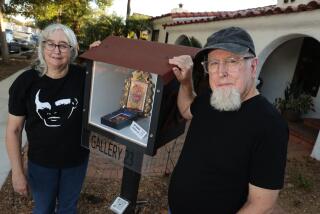UPGRADING VISIBILITY OF BLACK ART : 7-GALLERY WALKING TOUR OF BLACK ART
- Share via
In an attempt to raise the level of awareness of black art in Los Angeles, seven local galleries have joined forces to conduct “Gallery-Fest,” a gallery walk-through Saturday and Sunday from 2 to 6 p.m.
“This is the first time anything like this has been done in the black community,” said Alonzo Davis, organizer of the event and owner of Brockman Gallery. “This is the first time there has been a true collective force that has been supportive, financially as well as with time and effort.”
Davis said the walk-through is designed not only to provide a visual treat but to make people in the community aware of galleries in the area.
Galleries participating in the art tour include 43rd St. Gallery, which exhibits paintings, collectible dolls and ceramics; the Willows, a gallery and gift shop; Gallery Tanner, an art gallery with changing exhibits; Cooper’s Originals, which carries reproductions of historical black photographs; Uranus, featuring African-American crafts and jewelry; Black Gallery, exhibiting art photography, and Brockman Gallery & Associates, which features art and crafts.
Tour maps will be available at the galleries for those who wish to visit on their own. Guided bus tours will depart from Brockman Gallery, 4334 Degnan Blvd.
“These galleries are small and do not have the budget or financial backing to operate in a mainstream way,” Davis said. “Because of this, very few are in the position to publish color brochures and do expensive marketing or distribution.”
Since last year, the number of galleries in what is known as the Crenshaw District has grown from three to seven. The oldest of these is Cooper’s, which celebrated its 20th year last month, followed by Brockman, which opened in 1967, and the nine-year-old Gallery Tanner.
Davis believes the sudden growth in galleries reflects an increased interest that has a lot to do with the recent openings of the California Afro-American Museum in Exposition Park and the Museum of African American Art in the Crenshaw May Co.
“More attention is being paid to the museums and our culture,” Davis said. “All this activity can’t help but make people feel there is a potential for cultural art.”
Because of the common thread that runs through each gallery, the decision to stick together has become one of urgency. “We felt there was a need to have a united front and work together instead of separately,” Davis said. “We realized that if we wanted to be seen, we’d have to let the communities know that we are here.”
“The cooperation among the galleries has created a bond, a new kind of spirit and a camaraderie,” said Roland Charles, co-owner of the Black Gallery.
Although the galleries are in a predominantly black area, Davis contends that the art is not limited to, or aimed at, a certain audience. “We have a larger audience than just Baldwin Hills,” says the self-taught artist. “What we are trying to do is offer alternative art to the general public. We are hoping that when people leave the art tour, they’ll leave knowing that there are alternative sources for purchasing art.”
The success of each gallery is also a goal of the tour, said Davis, who added that he hopes galleries will broaden their base of clientele. “If these galleries are successful financially, then they will have the potential to do more for young artists, which means galleries can afford to exhibit more artists,” Davis said.
Charles added, “We want to appeal universally to all people.”
Sorey, a graduate of USC, is a Times intern.
More to Read
The biggest entertainment stories
Get our big stories about Hollywood, film, television, music, arts, culture and more right in your inbox as soon as they publish.
You may occasionally receive promotional content from the Los Angeles Times.










